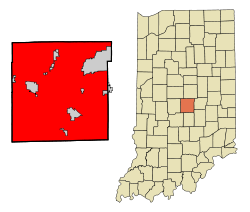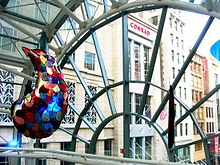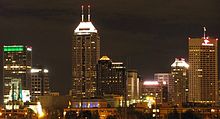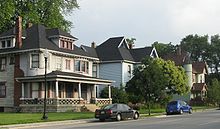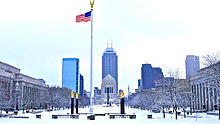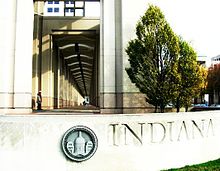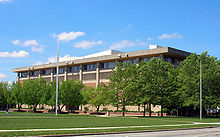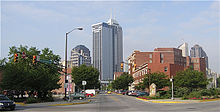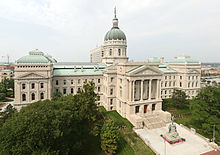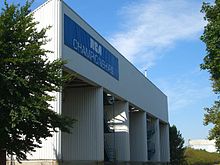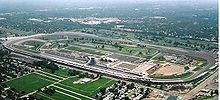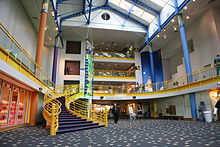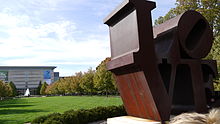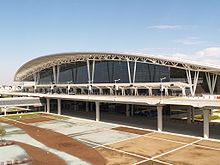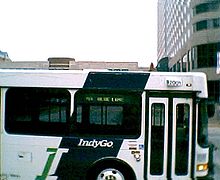- Indianapolis
-
This article is about the capital of Indiana. For other uses, see Indianapolis (disambiguation).
Indianapolis Downtown Indianapolis taken from Crown Hill, with the Chase Tower in the center. 
Flag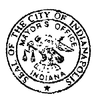
SealNickname(s): Indy, The Circle City,
Crossroads of America, The Racing Capital of the World, Amateur Sports Capital of the WorldLocation in the state of Indiana Location in the United States Coordinates: 39°46′5.88″N 86°9′29.52″W / 39.7683°N 86.1582°W Country United States State Indiana County Marion Townships See Marion Co. Townships Founded 1821 Government – Type Mayor-council – Mayor Gregory A. Ballard (R) – Governing body City-County Council Area – City 372 sq mi (963.5 km2) – Land 365.1 sq mi (945.6 km2) – Water 6.9 sq mi (17.9 km2) Elevation 715 ft (218 m) Population (2011)[1] – City 839,489 (12th) – Density 2,273/sq mi (861/km2) – Urban 1,219,000 – Metro 1,756,241 (34th) – Demonyms Indianapolitan Time zone EST (UTC-5) – Summer (DST) EDT (UTC-4) ZIP Codes 46201 – 46209, 46211, 46214
46216 – 46231, 46234 – 46237
46239 – 46242, 46244, 46247
46249 – 46251, 46253 – 46256
46259, 46260, 46266, 46268
46274, 46275, 46277, 46278
46280, 46282, 46283, 46285
46290, 46291, 46295, 46296
46298Area code(s) 317 Twin Cities – Campinas  Brazil
Brazil– Cologne  Germany
Germany– Eldoret  Kenya
Kenya– Hangzhou  China
China– Hyderabad  India
India– Monza  Italy
Italy– Piran  Slovenia
Slovenia– Taipei  Republic of China
Republic of ChinaFIPS code 18-36003[2] Interstates I-65, I-69, I-70, I-74 Interstate Spurs I-465, I-865 Waterways White River Airports Indianapolis International Airport Public transit IndyGo
Clarian Health People MoverRailroads Amtrak Website http://www.indy.gov Indianapolis
 /ˌɪndiəˈnæpɵlɨs/ (abbreviated Indy /ˈɪndi/) is the capital of the U.S. state of Indiana, and the county seat of Marion County, Indiana. As of the 2010 United States Census, the city's population is 839,489.[3] It is by far Indiana's largest city and, as of the 2010 U.S. Census, is the 12th largest city in the U.S., the second largest city in the Midwest (behind Chicago), the second most populous state capital (after Phoenix, Arizona), and the most populous state capital east of the Mississippi River. Indianapolis is also one of the fastest growing regions in the United States.[4]
/ˌɪndiəˈnæpɵlɨs/ (abbreviated Indy /ˈɪndi/) is the capital of the U.S. state of Indiana, and the county seat of Marion County, Indiana. As of the 2010 United States Census, the city's population is 839,489.[3] It is by far Indiana's largest city and, as of the 2010 U.S. Census, is the 12th largest city in the U.S., the second largest city in the Midwest (behind Chicago), the second most populous state capital (after Phoenix, Arizona), and the most populous state capital east of the Mississippi River. Indianapolis is also one of the fastest growing regions in the United States.[4]For much of its history, Indianapolis has oriented itself around government and industry, particularly manufacturing. Today, Indianapolis has a much more diversified economy, contributing to the fields of education, health care, and finance. Tourism is also a vital part of the economy of Indianapolis, and the city plays host to numerous conventions and sporting events. Of these, perhaps the most well known is the annual Indianapolis 500. Other major sporting events include the Brickyard 400 and the Men's and Women's NCAA Basketball Tournaments. 2012 will mark the first time Indianapolis will play host to the Super Bowl. Super Bowl XLVI will be played at Lucas Oil Stadium, on February 5, 2012 in Downtown Indianapolis.
Greater Indianapolis has seen moderate growth among U.S. cities,[5] especially in nearby Hamilton, Hendricks, and Johnson counties.[6] The population of the metropolitan statistical area was 1,756,241 according to the 2010 Census, making it the 34th-largest in the United States. The 2010 population of the Indianapolis combined statistical area, a larger trade area, was 2,080,782, the 23rd-largest in the country.
Contents
History
For more details on this topic, see History of Indianapolis.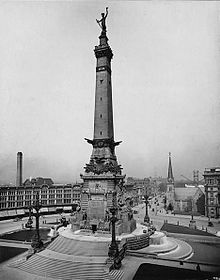 The Soldiers' and Sailors' Monument c.1901.
The Soldiers' and Sailors' Monument c.1901.
Native Americans who lived in the area originally included the Miami and Lenape (or Delaware) tribes, but they were displaced from the area by the early 1820s.[7]
Indianapolis was selected as the site of the new state capital in 1820, the old state capital having been Corydon since the formation of the state of Indiana. While most American state capitals tend to be located in the central region of their respective states, Indianapolis is the closest capital to being placed in the exact center of its state.[8] It was founded on the White River both because of this, and because of the incorrect assumption that the river would serve as a major transportation artery. However, the waterway eventually proved to be too sandy for trade. Jeremiah Sullivan, a judge of the Indiana Supreme Court, invented the name Indianapolis by joining Indiana with polis, the Greek word for city; Indianapolis literally means "Indiana City". The state commissioned Alexander Ralston to design the new capital city. Ralston was an apprentice to the French architect Pierre L'Enfant, and he helped L'Enfant plan Washington, D.C.. Ralston's original plan for Indianapolis called for a city of only one square mile (3 km²). At the center of the city sat Governor's Circle, a large circular commons, which was to be the site of the governor's mansion. Meridian and Market Streets converge at the Circle and continue north-south and east-west, respectively.The Capital moved from Corydon on January 10, 1825. The governor's mansion was eventually demolished in 1857 and in its place stands a 284-foot (87 m) tall neoclassical limestone and bronze monument, the Indiana Soldiers' and Sailors' Monument. The surrounding street is now known as Monument Circle.
The city lies on the original east-west National Road. The first railroad to service Indianapolis, the Madison and Indianapolis, began operation on October 1, 1847, and subsequent railroad connections made expansive growth possible. Indianapolis was the home of the first Union Station, or common rail passenger terminal, in the United States. By the turn of the century, Indianapolis had become a large automobile manufacturer, rivaling the likes of Detroit. With roads leading out of the city in all directions, Indianapolis became a major hub of regional transport connecting to Chicago, Louisville, Cincinnati, Columbus, Detroit, Cleveland and St. Louis, befitting the capital of a state whose nickname is "The Crossroads of America." This same network of roads would allow quick and easy access to suburban areas in future years.
City population grew rapidly throughout the first half of the 20th century. While rapid suburbanization began to take place in the second half of the century, race relations deteriorated.[citation needed] Even so, on the night that Martin Luther King, Jr. was assassinated, Indianapolis was the only major city in which rioting did not occur.[9] Many credit the speech by Robert F. Kennedy, who was in town campaigning for President that night, for helping to calm the tensions. Racial tensions heightened in 1970 with the passage of Unigov, which further isolated the middle class from Indianapolis's growing African American community.[citation needed]. Although Indianapolis and the state of Indiana abolished segregated schools just prior to Brown vs. Board of Education, the later action of court-ordered school desegregation busing by Judge S. Hugh Dillin was a controversial change.
 Sports have been an important part of the growth and reputation of Indianapolis. Pictured here is the RCA Dome, which was home of the Indianapolis Colts for 25 years.
Sports have been an important part of the growth and reputation of Indianapolis. Pictured here is the RCA Dome, which was home of the Indianapolis Colts for 25 years.
In the 1970s and 1980s, Indianapolis suffered at the hands of urban decay and white flight. Major revitalization of the city's blighted areas, such as Fall Creek Place, and especially the downtown, began in the 1990s and led to an acceleration of growth on the fringes of the metropolitan area. The opening of Circle Centre in downtown Indianapolis jump started a major revitalization of the central business district. The city hosted the 1987 Pan American Games.
The 1970s and 1980s ushered in a period of planning and revitalization for the urban core of Indianapolis. Changes came early with the reorientation of the city’s government. Unigov was created as the result of a 1970 consolidation between city and county government. The city of Indianapolis merged most government services with those of Marion County. For the most part, this resulted in a unification of Indianapolis with its immediate suburbs. This caused the boundaries of the city to grow tremendously and would be reflected in Indianapolis’ jump to the rank of America’s 11th largest city in 1970. The City-County Building housed the newly consolidated government. At its completion, the City-County Building became the city’s tallest building and the first building in the city to be taller than the Soldiers' and Sailors' Monument. Amidst the changes in government and growth, the city’s role as a major transportation hub and tourist destination was further strengthened with the Weir Cook Municipal Airport receiving its international designation in 1975.
The city and state have invested heavily in improvement projects such as an expansion to the Convention Center, upgrading of the I-465 beltway, and construction of an entirely new airport terminal for the Indianapolis International Airport, which is now open.[10] Construction of the Indianapolis Colts' new home, Lucas Oil Stadium, was completed in August 2008, and the hotel and convention center expansion were completed in early 2011.
Geography
According to the United States Census Bureau, the balance (the part of Marion County not part of another municipality) has a total area of 368.2 square miles (954 km2) – 361.5 square miles (936 km2) of it is land and 6.7 square miles (17 km2) of it is water. The total area is 1.81% water. These figures do not, however, represent the entire Consolidated City of Indianapolis (all of Marion County, except the four excluded communities). The total area of the Consolidated City of Indianapolis, not including the four excluded communities, covers approximately 373.1 square miles (966 km2).
At the center of Indianapolis is the Mile Square, bounded by four appropriately named streets: East, West, North, and South Streets. Nearly all of the streets in the Mile Square are named after U.S. states. The exceptions are Meridian Street, which numerically divides west from east; Market Street, which intersects Meridian Street at Monument Circle; Capitol and Senate Avenues, where many of the Indiana state government buildings are located; and Washington Street, which was named after President George Washington. The street-numbering system centers not on the Circle, but rather one block to the south, where Meridian Street intersects Washington Street (part of the historic National Road).
Indianapolis is situated in the Central Till Plains region of the United States. Two natural waterways dissect the city: the White River and Fall Creek.
Physically, Indianapolis is similar to many other Midwestern cities. A mix of deciduous forests and prairie covered much of what is considered Indianapolis prior to the 19th century. Land within the city limits varies from flat to gently sloping; most of the changes in elevation are so gradual that they go unnoticed and appear to be flat at close range. The mean elevation for Indianapolis is 717 feet (219 m). The highest point in Indianapolis lies on the northeast side of the city. It was previously assumed that the highest point was Crown Hill Cemetery (the tomb of famed Hoosier writer James Whitcomb Riley) with an elevation of 842 feet (257 m). The lowest point in Indianapolis lies at the Marion County/Johnson County line, with an elevation of about 680 feet (207 m). The highest hill in Indianapolis is Mann Hill, a bluff located along the White River in Southwestway Park that rises about 150 feet (46 m) above the surrounding land. Variations in elevation from 700–900 feet occur throughout the city limits. There are a few moderately sized bluffs and valleys in the city, particularly along the shores of the White River, Fall Creek, Geist Reservoir, and Eagle Creek Reservoir, and especially on the city's northeast and northwest sides.
Climate
Indianapolis has a humid continental climate (Köppen climate classification Dfa). Like most cities in the Midwest, it has four distinct seasons. Summers are hot and humid, with high temperatures regularly approaching 90 °F (32 °C), with some days exceeding 95 °F (35 °C). Spring and autumn are usually pleasant, with temperatures reaching around 65 °F (18 °C). Spring, however, is much less predictable than autumn; midday temperature drops exceeding 30 °F (16.7 °C)) are common during March and April, and instances of very warm days (86 °F/30 °C) followed within 36 hours by snowfall are not unheard of during these months. Winters are cool to cold, with daily highs barely inching above freezing. Temperatures occasionally dip below 0 °F (−18 °C) on 7 nights per year.[11] The rainiest months are in the spring and summer, with average rainfall of over four inches (100 mm) per month, mostly derived from thunderstorm activity; there is no distinct dry season with slightly higher summer averages.
The city's average annual precipitation is 41 inches (1,040 mm).
The mean July temperature is 75.4 °F (24.1 °C), and the corresponding figure for January is 26.5 °F (−3.1 °C). The record high for Indianapolis is 106 °F (41 °C), on July 25, 1954. The record low is −27 °F (−33 °C), on January 19, 1994. Average annual snowfall is 27 inches (69 cm).[12]
Climate data for Indianapolis (Indianapolis International Airport) Month Jan Feb Mar Apr May Jun Jul Aug Sep Oct Nov Dec Year Record high °F (°C) 71
(22)76
(24)85
(29)90
(32)96
(36)102
(39)106
(41)103
(39)100
(38)91
(33)81
(27)74
(23)106
(41)Average high °F (°C) 34.5
(1.4)39.9
(4.4)51.4
(10.8)62.9
(17.2)73.5
(23.1)82.1
(27.8)85.6
(29.8)83.7
(28.7)77.4
(25.2)65.6
(18.7)51.6
(10.9)39.2
(4.0)62.3 Average low °F (°C) 18.5
(−7.5)22.5
(−5.3)32.0
(0.0)41.2
(5.1)51.8
(11.0)61.3
(16.3)65.2
(18.4)63.3
(17.4)55.2
(12.9)43.6
(6.4)34.1
(1.2)24.0
(−4.4)42.7 Record low °F (°C) −27
(−33)−21
(−29)−7
(−22)18
(−8)28
(−2)37
(3)46
(8)41
(5)30
(−1)20
(−7)−5
(−21)−23
(−31)−27
(−33)Precipitation inches (mm) 2.48
(63)2.41
(61.2)3.44
(87.4)3.61
(91.7)4.36
(110.7)4.13
(104.9)4.42
(112.3)3.82
(97)2.88
(73.2)2.76
(70.1)3.61
(91.7)3.03
(77)40.95
(1,040.1)Snowfall inches (cm) 8.9
(22.6)6.1
(15.5)3.1
(7.9)0.4
(1)0
(0)0
(0)0
(0)0
(0)0
(0)0.4
(1)1.3
(3.3)6.4
(16.3)26.7
(67.8)Avg. precipitation days (≥ 0.01 in) 13.1 10.7 13.1 12.6 12 10.4 9.8 9.4 8.1 8.8 10.9 12.6 131.5 Avg. snowy days (≥ 0.1 in) 7.7 5.5 2.9 0.8 0 0 0 0 0 0.2 1.9 5.7 24.7 Sunshine hours 133.3 146.9 179.8 216.0 263.5 288.0 294.5 272.8 234.0 195.3 117.0 102.3 2,443.4 Source: NOAA (normals 1971–2000),[11] The Weather Channel (records),[12] HKO (sun)[13] Cityscape
For more details on this topic, see List of tallest buildings in Indianapolis.High rise construction in Indianapolis started in 1888 with the 256-foot (78 m) high Indiana Statehouse, followed by the 284-foot (87 m) Soldiers' and Sailors' Monument in 1898. However, because of a special ordinance disallowing building higher than the structure, the monument remained the highest structure until the completion of the City-County Building in 1962.
In the 1970s, the central business district, like many other Rust Belt cities of the United States, saw decreased economic activity and, as a result, downtown Indianapolis saw little new construction. By the 1980s, the city of Indianapolis addressed these issues by developing plans to redefine the city's downtown and neighborhoods. Tall skyscrapers started being built to define Indianapolis's skyline, such as the One America building in 1982. This development also carried over to the 90's, when the Chase Tower was built.
Neighborhood development was also addressed. Indianapolis neighborhoods were designated in relation to their proximity to the city center, and plans were initiated for them to be redeveloped.
Demographics
Historical populations Census Pop. %± 1840 2,692 — 1850 8,091 200.6% 1860 18,611 130.0% 1870 48,244 159.2% 1880 75,056 55.6% 1890 105,436 40.5% 1900 169,164 60.4% 1910 233,650 38.1% 1920 314,194 34.5% 1930 364,161 15.9% 1940 386,972 6.3% 1950 427,173 10.4% 1960 476,258 11.5% 1970 744,624 56.3% 1980 700,807 −5.9% 1990 731,327 4.4% 2000 781,926 6.9% 2010 829,718 6.1% As of the 2011 Indiana Estimate, the population of Indianapolis is 839,489.[1] The population density is 2,230 persons per square mile.
At the 2010 Census, 58.6% of the population was non-Hispanic White, 27.2% non-Hispanic Black or African American, 0.2% non-Hispanic American Indian and Alaska Native, 2.1% non-Hispanic Asian, 0.3% from some other race (non-Hispanic) and 2.2% of two or more races (non-Hispanic). 9.4% of Indianapolis population was of Hispanic, Latino, or Spanish origin (who may be of any race).
Greater Indianapolis is a rapidly growing region located at the center of Indiana and consists of Marion County, Indiana and several adjacent counties. The Combined Statistical Area (CSA) of Indianapolis exceeded 2 million people in the 2007 estimate, ranking 23rd in the United States and 7th in the Midwest. As a unified labor and media market, the Indianapolis Metropolitan Statistical Area (MSA) had a 2010 population of 1.83 million people, ranking 33rd in the United States and 7th largest in the Midwest.
According to the 2006–2008 American Community Survey,[14] the racial composition of the city are 66.6% White (Non-Hispanic Whites: 63.3%), 25.9% Black or African American, 0.2% American Indian, 3.2% Asian, 3.4% from some other race, 2.1% are from two or more races. Hispanics or Latinos (of any race) make up 7.0% of the total population.
A University of Wisconsin–Milwaukee study recently concluded that Indianapolis is the least segregated city in the northern United States, with 25% of the population living on a city block with both white and black residents.[15][16]
There were 324,342 households out of which 29.8% had children under the age of 18 living with them, 40.7% were married couples living together, 15.0% had a female householder with no husband present, and 39.7% were non-families. 32.0% of all households were made up of individuals and 8.6% had someone living alone who was 65 years of age or older. The average household size was 2.39 and the average family size was 3.03.
The age distribution was 25.7% under 18, 10.1% from 18 to 24, 32.8% from 25 to 44, 20.4% from 45 to 64, and 11.1% who were 65 or older. The median age was 34 years. For every 100 females there were 93.7 males. For every 100 females age 18 and over, there were 90.1 males.
The median income for a household in the city was $40,154, and the median income for a family was $48,979. Males had a median income of $36,372 versus $27,757 for females. The per capita income for the city was $21,789. About 9.0% of families and 11.8% of the population were below the poverty line, including 16.1% of those under the age of 18 and 8.1% of those ages 65 or older.
Law and government
Main article: Government of Indianapolis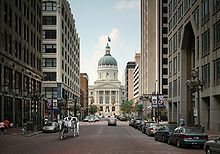 The Indiana State Capitol in Indianapolis.
The Indiana State Capitol in Indianapolis.
Indianapolis has a consolidated city-county government known as Unigov. Under this system, many functions of the city and county governments are consolidated, though some remain separate. The city has a mayor-council form of government.
Mayor
Main article: List of mayors of IndianapolisThe executive branch is headed by an elected mayor, who serves as the chief executive of both the city and Marion County. The current Mayor of Indianapolis is Republican Greg Ballard. The mayor appoints city department heads and members of various boards and commissions.
City-County Council
The legislative body for the city and county is the City-County Council. It is made up of 29 members, 25 of whom represent districts, with the remaining four elected at large. As of 2009, Republicans hold a 15-13-1 majority over Democrats and a (formerly Republican) Libertarian. The council passes ordinances for the city and county and also makes appointments to certain boards and commissions.
Courts
With the exception of the United States District Court for the Southern District of Indiana, all of the courts of law in Indianapolis are part of the Indiana state court system. The Marion Superior Court is the court of general jurisdiction. The 35 judges on the court hear all criminal, juvenile, probate, and traffic violation cases, as well as most civil cases. The Marion Circuit Court hears certain types of civil cases. Small claims cases are heard by Small Claims Courts in each of Marion County's nine townships. The Appeals Courts and the Indiana Supreme Court meet in the Indiana Statehouse.
Fire protection
The Indianapolis Fire Department provides fire protection services for six townships in Marion County (Washington, Lawrence, Center, Warren, Perry, and Franklin), plus those portions of the other three townships that were part of Indianapolis prior to the establishment of Unigov. The individual fire departments of Decatur, Pike, and Wayne townships, the town of Speedway, and the cities of Beech Grove and Lawrence, provide such services for their respective jurisdictions.
Emergency medical services
Emergency medical services (EMS) for six townships in Indianapolis (Washington, Lawrence, Center, Warren, Perry and Franklin) and the Town of Speedway are provided by Indianapolis Emergency medical services. The fire departments of Decatur, Pike and Wayne Townships, as well as the cities of Beech Grove and Lawrence, provide EMS services to their respective jurisdictions.
Law enforcement
Indianapolis and Marion County historically maintained separate police agencies: the Indianapolis Police Department and Marion County Sheriff's Department. On January 1, 2007, a new agency, the Indianapolis Metropolitan Police Department, was formed by merging the two departments. IMPD is a separate agency, as the Sheriff's Department maintains jail and court functions. IMPD has jurisdiction over those portions of Marion County not explicitly covered by the police of an excluded city or by a legacy pre-Unigov force. As of February 29, 2008, the IMPD is headed by a Public Safety Director appointed by the Mayor of Indianapolis; the Public Safety Director appoints the Police Chief. The IMPD was formerly under the leadership of the Sheriff of Marion County, Frank J. Anderson. The Sheriff remains in charge of the County Jail and security for the City-County Building, service of warrants, and certain other functions. The Sheriff must be consulted, but does not have final say, on the appointment of the Public Safety Director and the Police Chief.[17]
Crime
In the late 1990s, violent crimes in inner-city neighborhoods located within the old city limits (pre-consolidation) peaked. The former Indianapolis Police District (IPD), which serves about 37% of the county's total population and has a geographic area covering mostly the old pre-consolidation city limits, recorded 130 homicides in 1998 to average approximately 40.3 homicides per 100,000 people. This is over 6 times the 1998 national homicide average of 6.3 per 100,000 people.[citation needed] Meanwhile, the former Marion County Sheriff's Department district serving the remaining 63% of the county's population, which includes the majority of the residents in the Consolidated City, recorded only 32 homicides in 1998, averaging about 5.9 murders per 100,000 people, slightly less than the 1998 national homicide average. Homicides in the IPD police district dropped dramatically in 1999 and have remained lower through 2005. In 2005, the IPD police district recorded 88 homicides to average 27.3 homicides per 100,000 people; nonetheless, the murder rate in the IPD is still almost 5 times the 2005 national average. In 2007, city leaders such as Sheriff Frank J. Anderson and former Mayor Bart Peterson held rallies in neighborhoods in effort to stop the violence in the city. In 2008, 122 homicides were recorded in Indianapolis.[citation needed]
It is important to note that Indianapolis is unique in its incorporation of historically suburban areas into the official "city limits" since the establishment of Unigov in 1970.[18] This can make the overall numbers for the city misleading, as crime rates in working class inner-city neighborhoods are diluted by the low suburban crime rates incorporated in the city statistics. Thus, violent crime and property crime rates that nonetheless both rank in the top 15 nationally would be considerably higher if they actually reflected the urban "pre-consolidation" Indianapolis and not its historic suburbs as well.
The immediate downtown area of the city around most main attractions, venues, and museums remain relatively safe. IMPD uses horseback officers and bicycle officers to patrol the downtown area or the city. Certain areas of Indianapolis remain a challenge for law enforcement officials. Indianapolis was ranked as the 33rd most dangerous city in the United States in the 2008–2009 edition of CQ Press's City Crime Rankings.[19]
Politics
Until the late 1990s, Indianapolis was considered to be one of the most conservative metropolitan areas in the country but this trend is reversing. Republicans had held the majority in the City-County Council for 36 years, and the city had a Republican mayor for 32 years from 1967 to 1999. This was in part because the creation of Unigov added several then-heavily Republican areas of Marion County to the Indianapolis city limits. More recently, Republicans have generally been stronger in the southern and western parts (Decatur, Franklin, Perry, and Wayne, townships) of the county while Democrats have been stronger in the central and northern parts (Center, Pike, and Washington townships). Republican and Democratic prevalence is split in Warren and Lawrence townships.[20] Outside of Marion County and the city proper, Republicans hold strong majorities in the suburbs of the metropolitan area.
In the 1999 municipal election, Democrat Bart Peterson defeated Indiana Secretary of State Sue Anne Gilroy by 52% to 41%. Four years later, Peterson was re-elected with 63% of the vote over Marion County Treasurer Greg Jordan. Republicans narrowly lost control of the City-County Council that year. In 2004, Democrats won the Marion County offices of treasurer, surveyor and coroner for the first time since the 1970s. The county GOP lost further ground during the 2006 elections with Democrats winning the offices of county clerk, assessor, recorder and auditor. Only one GOP countywide office remained: Prosecutor Carl Brizzi, who defeated Democratic challenger Melina Kennedy with 51% of the vote in his bid for a second term, despite outspending her two-to-one. At the township level, Democrats picked up the trustee offices in Washington, Lawrence, Warren and Wayne townships, while holding on to Pike and Center townships.
In the 2007 municipal election, fueled by voter angst against increases in property and income taxes as well as a rise in crime, Republican challenger Greg Ballard narrowly defeated Peterson 51% to 47%—the first time an incumbent Indianapolis mayor was removed from office since 1967. Discontent among these issues also returned control of the City-County Council to the GOP with a 16–13 majority.[21]
In the 2008 presidential election, Barack Obama easily won in Indianapolis by earning 64% of all Marion County votes while 35% of the votes went to John McCain.[22]
As 2010 came to an end, despite a strong performance by the GOP statewide, Democrats swept all county offices once again, including reclaiming the office of county prosecutor for the first time since 1990.
Most of Indianapolis is within the 7th Congressional District of Indiana, represented by Democrat André Carson. He is the grandson of the district's previous representative, Julia Carson who held the seat from 1997 until her death on December 15, 2007.[23] The younger Carson, a former member of the City-County Council, won the seat in a special election on March 11, 2008. The northeastern and southeastern portions of the city are in the 5th District, represented by Republican Dan Burton. A portion of western Indianapolis is in the 4th District, represented by Republican Steve Buyer.
Education
Main article: List of schools in IndianapolisHigher education
Amongst the many institutes of higher education in Indianapolis is Indiana University-Purdue University Indianapolis, a shared campus for the two largest university systems in Indiana. Pictured here is Cavanaugh Hall, the home of the School of Liberal Arts and several administrative offices for the campus.
Indianapolis is the home of: Ball State University Indianapolis Center, Butler University, Indiana University-Purdue University Indianapolis (IUPUI), Ivy Tech Community College of Indiana, Marian University, Martin University, Oakland City University Indianapolis campus, The Art Institute of Indianapolis, Vincennes University Aviation Technology Center, the University of Indianapolis, the University of Phoenix, and WGU Indiana.
Butler University was originally founded in 1855 as North Western Christian University. The school purchased land in the Irvington area in 1875. The school moved again in 1928 to its current location at the edge of the Butler-Tarkington neighborhood. The school removed itself officially from religious affiliation, giving up the theological school to Christian Theological Seminary. A private institution, Butler's current student enrollment is approximately 4,400. Butler has a storied sports heritage in regards to basketball and volleyball. Butler is the site where both the film Hoosiers and the events that inspired it where filmed, the so called Milan Miracle. Butler's basketball stadium, Hinkle Fieldhouse, was the largest basketball facility when built and also historically hosted the first bout between the U.S. and Soviet Union in basketball. Butler University made its own impact felt with a championship appearance in its home city of Indianapolis in the NCAA championship game in 2010, and a repeat appearance in the NCAA Championship game in 2011. Butler also has hosted to date the largest attended volleyball match at 14,000 spectators.
Indiana University-Purdue University Indianapolis was originally an urban conglomeration of branch campuses of the two major state universities: Indiana University in Bloomington and Purdue University in West Lafayette, created by the state legislature. In 1969 a merged campus was created at the site of the Indiana University School of Medicine. IUPUI's student body is currently just above 30,000, making it the third-largest campus for higher learning in Indiana after the main campuses of IU and Purdue. The Indiana University School of Law – Indianapolis is located on the IUPUI campus; the school's distinctive Inlow Hall is located on the Southeast corner of the campus. This campus is also home to Herron School of Art and Design, which was established privately in 1902. A new building was built in 2005 under both private donation and state contribution enabling the school to move from its original location. IUPUI has a division one basketball program and has made tournament appearances in the Summit League alongside Indianapolis's other division one school, Butler University. IUPUI has the only Android Studies Department in the United States.
Ivy Tech Community College of Indiana, a state funded public school, was founded as Indiana Vocational Technical College in 1963. With 23 campuses across Indiana, Ivy Tech has a total enrollment of 86,130, as of 2008, according to the school's website.
Marian University was founded in 1936 when St. Francis Normal and Immaculate Conception Junior College merged. The college moved to Indianapolis in 1937. Marian is currently a private Catholic school and has an enrollment of approximately 1,800 students.
The University of Indianapolis is a private school affiliated with the United Methodist Church. Founded in 1902 as Indiana Central University, the school currently hosts almost 4,300 students. The University of Indianapolis prides itself on its teaching and nursing programs, as well as its opportunities to study abroad. UIndy has satellite campuses in Cyprus, Jerusalem, and at the base of the Acropolis in Athens. The University of Indianapolis will host the practice facilities for one of the opponents in Super Bowl XLVI in 2012.
Primary and secondary education
Indianapolis has eleven unified public school districts (eight township educational authorities and three legacy districts from before the unification of city and county government), each of which providing primary, secondary, and adult education services within its boundaries. The boundaries of these districts do not exactly correspond to township (or traditional) boundaries, but rather cover the areas of their townships that were outside the pre-Unigov city limits. Indianapolis Public Schools served all of Indianapolis prior to 1970 and is still the city's largest school corporation today.
Private schools run by the Archdiocese of Indianapolis are Bishop Chatard, Roncalli, Cardinal Ritter, and Scecina. Other private schools include Brebeuf, Park Tudor, Cathedral and Heritage Christian.
Libraries
Public library services are provided to the citizens of Indianapolis and Marion County by the Indianapolis-Marion County Public Library (IMCPL). The educational and cultural institution, founded in 1873, now consists of a main library, Central Library, located in downtown Indianapolis, and 22 branch locations spread throughout the city. Serving over 5.43 million visitors in 2006, IMCPL's mission is to provide "materials and programs in support of the lifelong learning, recreational and economic interests of all citizens of Marion County." The renovated Central Library building opened on December 9, 2007, ending a controversial multi-year rebuilding plan.[24]
Cultural features
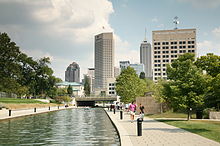 The Central Canal in Indianapolis
The Central Canal in Indianapolis
Indianapolis prides itself on its rich cultural heritage. Several initiatives have been made by the Indianapolis government in recent years to increase Indianapolis's appeal as a destination for arts and culture.
- Cultural Districts
For more details on this topic, see Indianapolis Cultural Districts.Indianapolis has designated six official Cultural Districts. They are Broad Ripple Village, Massachusetts Avenue, Fountain Square, The Wholesale District, Canal and White River State Park, and Indiana Avenue. These areas have held historic and cultural importance to the city. In recent years they have been revitalized and are becoming major centers for tourism, commerce and residential living.
- Cultural Trail
Scheduled to be complete by 2011, the Indianapolis Cultural Trail: is a urban bike and pedestrian path that connects the city's five downtown Cultural Districts, neighborhoods and entertainment amenities, and serves as the downtown hub for the entire central Indiana greenway system. The trail includes benches, bike racks, lighting, signage and bike rentals/drop-offs along the way and also features local art work.
- Monument Circle
At the center of Indianapolis is Monument Circle, a traffic circle at the intersection of Meridian and Market Streets, featuring the Soldiers' and Sailors' Monument. Monument Circle is depicted on the city’s flag. It is in the shadow of Indiana's tallest skyscraper, the Chase Tower. Until the early 1960s, Indianapolis zoning laws stated that no building could be taller than the Soldiers and Sailors Monument. Each Christmas season, lights are strung onto the monument and lit in a ceremony known as the Circle of Lights, which attracts tens of thousands of Hoosiers to downtown Indianapolis on the day after Thanksgiving.
- War Memorial Plaza
Main article: Indiana World War Memorial PlazaA five-block plaza at the intersection of Meridian and Vermont surrounds a large memorial dedicated to Hoosiers who have fought in American wars. It was originally constructed to honor the Indiana soldiers who died in World War I, but construction was halted due to lack of funding during the Great Depression, and it was finished in 1951. The purpose of the memorial was later altered to encompass all American wars in which Hoosiers fought.
The monument is modeled after the Mausoleum of Maussollos. At 210 feet (64 m) tall it is approximately seventy-five feet taller than the original Mausoleum. On the north end of the War Memorial Plaza is the national headquarters of the American Legion and the Indianapolis-Marion County Public Library's Central Library.
- Indiana Statehouse
For more details on this topic, see Indiana Statehouse.The Statehouse houses the Indiana General Assembly, the Governor of Indiana, state courts, and other state officials.
- Monuments
The city is second only to Washington, D.C., for the number of war monuments inside city limits.[25]
- The Soldiers' and Sailors' Monument, located at Monument Circle in the geographic center of the city.
- Indiana World War Memorial Plaza
- Medal of Honor Memorial
- USS Indianapolis Memorial
- Landmark for Peace Memorial
- Project 9/11 Indianapolis
- Other heritage and history attractions
- American Legion National Headquarters
- Crown Hill Cemetery
- James Whitcomb Riley Museum Home
- Lockerbie Square
- Cole-Noble District
- Indianapolis City Market
- Madame Walker Theatre Center
- Morris-Butler House
- Obelisk Square
- President Benjamin Harrison Home
- Scottish Rite Cathedral
Conventions
In 2003, Indianapolis began hosting Gen Con, the largest role-playing game convention in the North America (with record attendance being over 30,000) at the Indiana Convention Center. Attendance of the event is expected to increase as the center is expanded. The convention center has also recently hosted to events such as Star Wars Celebration II and III, which brought in Star Wars fans from around the world, including George Lucas.
Indianapolis will host the National FFA Convention from 2006 to 2012[26] and will rotate with Louisville every 3 years starting in 2013. The National FFA Organization|FFA]] Convention draws approximately 55,000 attendees and has an estimated $30–$40 million direct visitor impact on the local economy. Attendees occupy 13,000 hotel rooms in 130 metro-area hotels on peak nights during the four-day convention, making it the largest convention in the history of Indianapolis.
Organizations
Indianapolis has evolved into a center for music. The city plays host to Music for All, Inergy, Indy's Official Musical Ambassadors, the Percussive Arts Society, and the American Pianists Association.[27]
As well as being the home of the Indianapolis Symphony Orchestra, Indianapolis is also home to Bands of America (BOA), a nationwide organization of high school marching, concert, and jazz bands. Indianapolis is now also the international headquarters of Drum Corps International, a professional drum and bugle corps association.
Indianapolis has been the headquarters of the Kiwanis International organization since 1982. The organization and its youth-sponsored Kiwanis Family counterparts, Circle K International and Key Club International, administer all their international business and service initiatives from Indianapolis.
Indianapolis contains the national headquarters for twenty-six fraternities and sororities, many of which are congregated in the College Park area surrounding The Pyramids.
Festivals and events
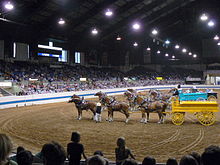 Horses on show during the Indiana State Fair at the Indiana State Fairgrounds
Horses on show during the Indiana State Fair at the Indiana State Fairgrounds
The International Violin Competition of Indianapolis, Indy Jazz Fest, and the DCI World Championships are all held in Indianapolis.
The Indianapolis Symphony Orchestra sometimes holds free outdoor concerts at various Indy Parks, and they annually hold an outdoor summer concert series called Symphony on the Prairie which attracts large crowds to Conner Prairie.
The city has an arts community that includes many fairs celebrating a wide variety of arts and crafts. They include the Broad Ripple Art Fair, Talbot Street Art Fair, Carmel Arts Festival, Indian Market and Festival, and the Penrod Art Fair.
Every May since 1957, Indianapolis has held the 500 Festival, a month of events including a mini marathon and a festival parade, the latter being the day before the Indianapolis 500.
Indianapolis is also home to the Indiana State Fair as well as the Heartland Film Festival, the Indianapolis International Film Festival, the Indianapolis Theatre Fringe Festival, the Indianapolis Alternative Media Festival, and the Midwest Music Summit.
The Circle City Classic is one of America’s top historically African-American college football games. This annual football game, held during the first weekend of October, is the showcase event of an entire weekend. The weekend is a celebration of cultural excellence and educational achievement while showcasing the spirit, energy and tradition of America’s historically black colleges and universities.
One of the largest ethnic and cultural heritage festivals in Indianapolis is the Summer Celebration held by Indiana Black Expo. This ten-day national event highlights the contributions of African-Americans to U.S. society and culture and provides educational, entertainment, and networking opportunities to the over 300,000 participants from around the country.
During the month of June, the Indianapolis Italian Street Festival is held at Holy Rosary Church just south of downtown.
Indy's International Festival is held annually in November at the Indiana State Fairgrounds. Local ethnic groups, vendors and performers are featured alongside national and international performers.
Since 2006, in the months of March and October, Midwest Fashion Week [2] takes place, promoting both local and national designers. Started by Berny Martin of Catou [3], this event has grown to become a premier event in Indianapolis.
Sports
Main article: Sports in IndianapolisIndianapolis Tennis Center, the main tennis court at the Indianapolis Tennis Championships, which Indianapolis hosted through 2009.
The labels of The Amateur Sports Capital of the World and The Racing Capital of the World have both been applied to Indianapolis.[28] The headquarters of the National Collegiate Athletic Association (NCAA), the main governing body for U.S. collegiate sports, is located in Indianapolis, as is the National Federation of State High School Associations. The city is home to the headquarters of three NCAA athletics conferences, the Horizon League (Division I), the Great Lakes Valley Conference (Division II, and the Heartland Collegiate Athletic Conference Division III. Since 2008, Indianapolis has hosted the Big Ten Conference Men's Basketball Tournament at Conseco Fieldhouse, which will host the tournament until 2015.[29] The national offices for the governing bodies of several sports are located in Indianapolis, including USA Gymnastics, USA Diving, US Synchronized Swimming, and USA Track & Field.
Indianapolis is a major automobile racing center. Since 1911 the Indianapolis 500 has been the premier event in the National Championship of open wheel car racing, the IndyCar Series. The series' headquarters and many of its teams are based in the city. Indianapolis is so well connected with racing that it has inspired the name "Indy car", used both for both the competition and the type of car used in it.[30] Indianapolis Motor Speedway hosts three major motor racing events every year: the Indianapolis 500, the Brickyard 400, and the Red Bull Indianapolis Grand Prix.
Indianapolis is home to two major league-level sports teams. The Indianapolis Colts of the National Football League (NFL) have been based in Indianapolis since relocating there in 1984, and play their home games in Lucas Oil Stadium. The Indiana Pacers of the National Basketball Association (NBA) play their home games at Conseco Fieldhouse; they began play in 1967 in the American Basketball Association (ABA) and joined the NBA when the leagues merged in 1976.
A number of minor league-level teams also play in the city. The Indiana Fever Women's National Basketball Association (WNBA) started play in 2000, and are the sister team to the Pacers NBA team. The Indianapolis Indians are the second oldest minor league baseball team, having played in the city since 1902, and are currently members of the Triple-A International League. The Indiana Ice ice hockey team began play in the United States Hockey League (USHL) in 2004.
Indianapolis hosted the Indianapolis Tennis Championships through 2009, one of the many tournaments which are part of the US Open Series. On May 20, 2008, the city was awarded the rights to host Super Bowl XLVI. Indianapolis hosted the 1987 Pan American Games and the 2002 World Basketball Championships.
Club Sport League Venue Indianapolis Colts Football National Football League Lucas Oil Stadium Indiana Pacers Basketball National Basketball Association Conseco Fieldhouse Indiana Fever Basketball Women's National Basketball Association Conseco Fieldhouse Indianapolis Indians Baseball International League (AAA – affiliated with the Pittsburgh Pirates) Victory Field Indiana Ice Hockey United States Hockey League Pepsi Coliseum Indianapolis Impalas[31] Rugby USA Rugby Old Central State Hospital Indianapolis Enforcers Indoor Football Continental Indoor Football League Travel Team Naptown Roller Girls Flat track roller derby Women's Flat Track Derby Association Pepsi Coliseum The Indianapolis Motor Speedway
For more details on this topic, see Indianapolis Motor Speedway.The Indianapolis Motor Speedway (IMS), located in Speedway, Indiana, is the site of the Indianapolis 500-Mile Race (also known as the Indy 500), an open–wheel automobile race held each Memorial Day weekend on a 2.5 miles (4.0 km) oval track. The Indy 500 is the largest single–day sporting event in the world, hosting more than 257,000 permanent seats (not including the infield area). The track is often referred to as the Brickyard, because it was paved with 3.2 million bricks shortly after its construction in 1909. Today the track is paved in asphalt, although a one–yard strip of bricks remains at the start/finish line.
IMS also hosts the NASCAR Sprint Cup Series' Brickyard 400. The first running of the Brickyard 400 was in 1994, and it is currently NASCAR's highest attended event.[citation needed] Jeff Gordon has frequented victory lane four times at Indianapolis, the most of any NASCAR driver.
From 2000 to 2007, IMS hosted the Formula One United States Grand Prix (USGP). Contract negotiations between IMS and Formula One resulted in a discontinuation of the USGP at Indianapolis in 2007. The USGP was not a part of the Formula One calendar from 2008–2010 (and will not be in 2011), but will be held in Austin, Texas starting in 2012.
The Speedway hosted its first MotoGP event in 2008, with the Red Bull Indianapolis Grand Prix taking place in September. Each year the event has been held, there has been a different rider in victory circle (Valentino Rossi in 2008, Jorge Lorenzo in 2009, Dani Pedrosa in 2010, and Casey Stoner in 2011).
Lucas Oil Raceway at Indianapolis
For more details on this topic, see Lucas Oil Raceway at Indianapolis.Indianapolis is also home to Lucas Oil Raceway at Indianapolis. Though not as well known as Indianapolis Motor Speedway, Lucas Oil Raceway is home to the NHRA Mac Tool U.S. Nationals, the biggest, oldest, richest, and most prestigious drag race in the world, held every Labor Day weekend.
OneAmerica 500 Festival Mini-Marathon
For more details on this topic, see OneAmerica 500 Festival Mini-Marathon.Indianapolis is home to the largest mini-marathon (and eighth-largest running event) in America. 2007 was the 30th anniversary of the Mini, run in the first weekend in May every year. This event is part of the 500 Festival, its 50th year running. The race starts on Washington Street just off Monument Circle, goes to the brickyard, and ends on New York Street back downtown. The Mini has been sold out every year, with well over 35,000 runners participating.
Recreation
Parks
For more details on this topic, see List of parks in Indianapolis.Indianapolis has an extensive municipal park system with nearly 200 parks occupying over 10,000 acres (40 km2). The flagship Eagle Creek Park is the largest municipal park in the city, and ranks among the largest urban parks in the United States.[32]
Other major Indianapolis Regional parks include:
- Garfield Park (Established in 1881, it is the oldest city park in Indianapolis and contains a conservatory and sunken gardens. Located on the Near South Side)
- Riverside Park (Near West Side)
- Sahm Park (Northeast side)
- Southeastway Park (Franklin Township, Marion County)
- Southwestway Park (Decatur Township, Marion County)
- White River State Park (Just West of downtown. Has cultural, educational and recreational attractions as well as trails and waterways.)
Additionally, Indianapolis has an urban forestry program that is recognized by the National Arbor Day Foundation's Tree City USA standards.
Indianapolis Zoo
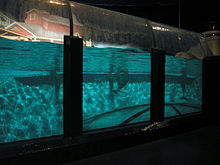 Amongst the many attractions at the Indianapolis Zoo is the dolphinarium
Amongst the many attractions at the Indianapolis Zoo is the dolphinarium
Opened in 1988, the Indianapolis Zoo is the largest zoo in the state, and is located just west of downtown in White River State Park. It has 360 species of animals, and is known for its dolphin exhibit, which includes the only underwater viewing dome in the Midwest.
Theaters and performing arts venues
Indianapolis is home to a wealth of venues for the performing arts. The following theaters offer plays, Broadway hits, comedy, musicals, concerts, and other live performances to Indy theater goers.
- Beef & Boards Dinner Theatre
- Clowes Memorial Hall at Butler University
- Indiana Repertory Theatre
- Indianapolis Symphony Orchestra at Hilbert Circle Theater
- Madame Walker Theatre Center
- Murat Theater
- Old National Centre
- Phoenix Theatre (Indianapolis)
Museums and galleries
Indianapolis has a wide variety of museums and galleries which appeal to art lovers, car enthusiasts, sports fans, history buffs, and science and technology brain acts.
- Children's Museum of Indianapolis (the largest children's museum in the world)[33]
- Indiana State Museum
- Indianapolis Art Center
- Indianapolis Museum of Art
- Indianapolis Artsgarden
- Indianapolis Museum of Contemporary Art
- Herron School of Art
- NCAA Hall of Champions (Hall of Fame for college athletics)
- Indianapolis Motor Speedway Hall of Fame Museum
- National Art Museum of Sport
- Colonel Eli Lilly Civil War Museum
- Eiteljorg Museum of American Indians and Western Art
- James Whitcomb Riley Museum Home
- Conner Prairie (A living history museum)
- Indiana Historical Society
- Indiana Medical History Museum
- Kurt Vonnegut Memorial Library
- Dean Johnson Gallery
Other places of interest
- Heslar Naval Armory
- Humane Society of Indianapolis
- Indiana State Fairgrounds
- Indianapolis-Marion County Public Library
- Irvington Historic District
- Slippery Noodle Inn
Local media
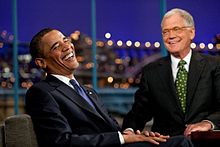 Comedian David Letterman—seen here interviewing President of the United States Barack Obama in 2009—started his career as a broadcaster in Indianapolis
Comedian David Letterman—seen here interviewing President of the United States Barack Obama in 2009—started his career as a broadcaster in Indianapolis Main article: Media in Indianapolis
Main article: Media in IndianapolisIndianapolis is served by local, regional, and national media.
National broadcast television affiliates include ABC affiliate WRTV (channel 6),[34] CBS affiliate WISH-TV (channel 8),[35] NBC affiliate WTHR (channel 13),[36] Fox affiliate WXIN (channel 59),[37] and PBS local affiliate WFYI (channel 20).[38]
The Indianapolis Star is the city's daily newspaper.
Economy
The largest industry sectors by employment in Indianapolis are manufacturing, health care and social services, and retail trade.[39] Compared to Indiana as a whole, the Indianapolis metropolitan area has a lower proportion of manufacturing jobs and a higher concentration of jobs in wholesale trade; administrative, support, and waste management; professional, scientific, and technical services; and transportation and warehousing.[39]
Companies
Many of Indiana's largest and most recognized companies are headquartered in Indianapolis, including pharmaceutical manufacturer Eli Lilly and Company, wireless distribution and logistics provider Brightpoint, health insurance provider Wellpoint, retailers Finish Line, Inc. and hhgregg Inc., Republic Airways Holdings [40] (including Chautauqua Airlines, Republic Airlines, Frontier Airlines, and Shuttle America), and REIT Simon Property Group. The U.S. headquarters of Roche Diagnostics, Technicolor SA, Conseco, First Internet Bank of Indiana, Dow AgroSciences, Emmis Communications, and Allison Transmission are also located in Indianapolis. Other major Indianapolis area employers include Indiana University Health, Sallie Mae, Cook Group, Rolls-Royce, Delta Faucet Company, Steak 'n Shake, and General Motors.
Indianapolis is a prime center for logistics and distribution facilities. It is home to a FedEx hub and distribution centers for companies such as Amazon.com, Foxconn, Finish Line, Target, and CVS Pharmacy.[41]
Before Detroit came to dominate the American automobile industry, Indianapolis was also home to a number of carmakers, including Duesenberg, Marmon Motor Car Company, Stutz Motor Company, American Motor Car Company, Parry Auto Company,[42] and Premier Motor Manufacturing.[43] In addition, Indianapolis hosted auto parts companies such as Prest-O-Lite, which provided acetylene generators for brass era headlights and acetylene gas starters.[44]
ATA Airlines (previously American Trans Air) was headquartered in Indianapolis prior to its collapse.[45]
Business Climate and Real Estate
The National Association of Home Builders and Wells Fargo ranked Indianapolis the most affordable major housing market in the U.S. for the fourth quarter of 2009,[46] and Forbes magazine ranked it the sixth-best city for jobs in 2008, based on a combined graded balance of perceived median household incomes, lack of unemployment, income growth, cost of living and job growth.[47] However, in 2008, Indiana ranked 12th nationally in total home foreclosures and Indianapolis led the state.[48]
In 2009, Indianapolis ranked first on CNN/Money's list of the top 10 cities for recent graduates.[49] In 2010, Indianapolis ranked 10th in the best cities for relocation by Yahoo Real Estate.[50]
In 2011, Indianapolis ranked sixth among U.S. cities as a retirement destination,[51] as one of the best Midwestern cities for relocation,[52] and best in a composite measure that considered local employment outlook and housing affordability.[53] Also a 2010 Study for Metro area GDP Ranked Indianapolis 10th best in the Nation for GDP Percent gain. http://www.urbanophile.com/2011/09/14/2010-gdp-data-shows-nascent-recovery-in-many-american-metros/
Transportation
Main article: Transportation in IndianapolisAirports
Indianapolis International Airport, airport code IND, is the largest airport in Indiana and serves the Indianapolis metropolitan area as well as many other communities in the state of the Indiana.
The airport is home to the second largest FedEx operation in the world (after the Memphis headquarters) and the United States Postal Service Eagle Network Hub. The entire airport is a global free trade zone called INZONE with 18 designated subzones.
Thirty years in planning, Indianapolis completed building a new airport in 2008. The $1.1 billion project is the largest development initiative in the city's history. The new Indianapolis Airport covers 1,200,000 square feet (110,000 m2), and has 40 gates, a 145,000 sq ft (13,500 m2) baggage processing area, a 73,000 sq ft (6,800 m2) baggage claim area, a large pre-security gathering, a concession space with a 60-foot (18 m) skylight, both local and national restaurants and retailers, and local Indianapolis artwork. The new terminal is the first built in the United States since September 11, 2001. It opened officially for arriving flights 11/11/08 and departures 11/12/08.
Ten major U.S. and international airlines serve Indianapolis International Airport.[54]
Highways
Interstate Highways
 Interstate 65
Interstate 65
 Interstate 69
Interstate 69
 Interstate 70
Interstate 70
 Interstate 74
Interstate 74
 Interstate 465
Interstate 465
 Interstate 865
Interstate 865Indiana Highways
 State Road 37
State Road 37
 State Road 67
State Road 67
 State Road 134
State Road 134
 State Road 135
State Road 135Several interstates serve the Indianapolis area. Interstate 65 runs northwest to Gary, where other roads eventually take drivers to Chicago, and southward to Louisville, Kentucky. Interstate 69 runs northeast to Fort Wayne, Indiana, and currently terminates in the city at I-465, but will eventually be routed around the city on 465 to the new extension of Interstate 69 towards Evansville. Interstate 70 follows the old National Road, running east to Columbus, Ohio and west to St. Louis, Missouri. Interstate 74 goes northwest towards Danville, Illinois, and southeast towards Cincinnati, Ohio. Finally, Interstate 465 circles Marion County and joins the aforementioned highways together. In 2002, the interstate segment connecting Interstate 465 to Interstate 65 on the northwest side of the city was redesignated Interstate 865 to reduce confusion. The Indianapolis area also has two other expressways: Sam Jones Expressway (formerly Airport Expressway), and Shadeland Avenue Expressway.
To comply with an Indiana state law limiting the number of miles of state highways, all US and Indiana State numbered routes were rerouted along I-465 instead of going through the center of the city. At one point (between Exits 47 and 49) on the southeast side of the city, I-465, US 31, US 36, US 40, US 52, US 421, Indiana 37, and Indiana 67 use the same right-of-way. Between Exits 49 and 2 (along the south end of the city), I-74, I-465, US 31, US 36, US 40, US 52, Indiana 37 and Indiana 67 operate on the same right-of-way.
Public transportation
The Indianapolis Public Transportation Corporation, known locally as IndyGo, provides public transportation for the city. IndyGo was established in 1975 after the city of Indianapolis took over the city's transit system. Prior to 1997, IndyGo was called Metro. Central Indiana Commuter Services (CICS), funded by IndyGo to reduce pollution, serves Indianapolis and surrounding counties.
Starting in 2010, private industry leaders from Central Indiana proposed a $10 billion multimodal regional transportation plan that includes expanded roadways, express bus routes, light rail, and commuter rail pathways. If public and legislative approval is granted, construction could begin as soon as 2012.
People mover
Main article: Indiana University Health People MoverIndiana University Health operates a people mover connecting the Indiana University School of Medicine, Riley Hospital for Children, Wishard Hospital and IUPUI facilities at the north end of the Downtown Canal with Methodist Hospital. It is open to the public but mostly used by doctors, staff, and patients of the various medical facilities. It is currently the only example of light or commuter rail in Indianapolis. The existing people mover is sometimes inaccurately described as a monorail, but in fact rides on dual concrete beams with the guideway as wide as the vehicle.
Intercity transportation
Amtrak, the national passenger rail system, provides service to Indianapolis at the Indianapolis Union Station. Amtrak provides a thrice-weekly service of the Cardinal to Chicago, New York City, Philadelphia, Washington, D.C. and the daily Hoosier State to Chicago.
Greyhound Lines and Megabus operate from Indianapolis Union Station downtown.
Indianapolis in popular media
- In the classic sitcom I Love Lucy, Fred Mertz was originally from Indianapolis and his mother still lived there. Before moving to New York and meeting the Ricardos, he and his wife, Ethel Mertz, ran a diner there.
- The 1969 Paul Newman film Winning is about the Indianapolis 500 and takes place at Indianapolis Motor Speedway.
- The television sitcom One Day at a Time was set in Indianapolis. The opening credits of the show include a shot of The Pyramids, a set of three distinctive office buildings located near the northwestern edge of the city.
- The 1986 basketball film Hoosiers was filmed in some parts of the Indianapolis area.
- The 1988 film Eight Men Out was filmed in Indianapolis, primarily at Bush Stadium.
- The first season of the television show Good Morning Miss Bliss (later to become Saved by the Bell) was set in Indianapolis.
- The television sitcom Thunder Alley was set in Indianapolis.
- The American version of the Men Behaving Badly was set in Indianapolis.
- The 1997 Ben Affleck film Going All the Way was set in Indianapolis.
- CBS's 2005 drama Close to Home was set in Indianapolis, revolving around a prosecuting attorney in Marion County.
- The 2007 film An American Crime is about the 1965 Indianapolis basement torture and murder of Sylvia Likens, starring Ellen Page and Catherine Keener. The film was nominated for a Golden Globe.
- A large segment of the 2008 film Eagle Eye takes place in Indianapolis.
- The 2009 film Amanda was set in Indianapolis.
- The cable TV reality series The Shift on the Investigation Discovery Channel followed Indianapolis's homicide unit.
- The television sitcom "Parks and Recreation" is set in a fictional Indiana city 90 miles (140 km) outside of Indianapolis called Pawnee. In an episode titled "Indianapolis", Leslie Knope and Ron Swanson drive to Indianapolis to receive a commendation. Also the episode "Road Trip" sees Leslie and Ben Wyatt travel to Indianapolis on assignment. The characters Ben and Chris Traeger are originally state auditors from Indianapolis.
- The Bob and Tom Show, a nationally syndicated radio show which is also televised by WGN America, is based out of WFBQ-FM (Q95) in Indianapolis.
- The Avett Brothers mention Indianapolis in their song "Salina."
- David Letterman, host of CBS's Late Show and the original host of NBC's Late Night, was born and raised in Indianapolis and began his broadcasting career there as a weatherman for WLWI-TV (now WTHR). His mother, Dorothy Mengering, who still lives in the Indianapolis area, has made frequent appearances on the show.
See also
Sister cities
Indianapolis has Eight sister cities, as designated by Sister Cities International:[55]
 – Campinas, Brazil
– Campinas, Brazil – Cologne, Germany
– Cologne, Germany – Eldoret, Kenya[56]
– Eldoret, Kenya[56] – Hangzhou, Zhejiang, China
– Hangzhou, Zhejiang, China – Hyderabad, India
– Hyderabad, India – Monza, Italy
– Monza, Italy – Piran, Slovenia
– Piran, Slovenia – Taipei, Taiwan
– Taipei, Taiwan
References
- ^ a b "U.S. Census Bureau Delivers Indiana's 2010 Census Population Totals". http://2010.Census.gov/news/releases/operations/cb11-cn26.html. Retrieved 11 February 2011.
- ^ "American FactFinder". United States Census Bureau. http://factfinder.census.gov. Retrieved 2008-01-31.
- ^ Cite error: Invalid
<ref>tag; no text was provided for refs named2011_Estimate; see Help:Cite errors/Cite error references no text - ^ Kotkin, Joel. "Fastest Growing Cities in the U.S.". Forbes. http://www.forbes.com/2010/10/11/cities-innovation-texas-great-plains-indianapolis-opinions-columnists-joel-kotkin_slide_11.html. Retrieved 14 March 2011.
- ^ "U.S. Census Figures". United States Census. 2006. http://www.census.gov/population/www/estimates/Estimates%20pages_final.html. Retrieved 2008-01-16.
- ^ Population growth – Indiana counties. Epodunk.com. Retrieved on 2010-12-24.
- ^ Bodenhamer, David J.; Robert Graham Barrows, David Gordon Vanderstel (1994). The Encyclopedia of Indianapolis. Indiana University Press. ISBN 0253312221. http://books.google.com/?id=bg13QcMSsq8C. p. 1042
- ^ Caldwell, Howard; Jones, Darryl (1990). Goodall, Kenneth. ed. Indianapolis. Bloomington: Indiana University Press. ISBN 0-253-32998-1. http://books.google.com/?id=BKLMAAAACAAJ. Retrieved 2008-12-25.
- ^ Morning Edition. "Robert Kennedy: Delivering News of King's Death". NPR. http://www.npr.org/templates/story/story.php?storyId=89365887. Retrieved 2010-07-01.
- ^ "Indiana Convention Center Expansion Revealed". WISH-TV. 2007-06-25. http://www.wishtv.com/global/story.asp?s=6707164. Retrieved 2008-01-16.
- ^ a b "NCDC: U.S. Climate Normals". National Oceanic and Atmospheric Administration. June 2011. http://cdo.ncdc.noaa.gov/climatenormals/clim20/in/124259.pdf. Retrieved 2009-03-20.
- ^ a b "Average Weather for Indianapolis International Airport, IN — Temperature and Precipitation". The Weather Channel. http://www.weather.com/outlook/travel/businesstraveler/wxclimatology/monthly/graph/IND:9. Retrieved 2010-06-28.
- ^ "Climatological Normals of Indianapolis". Hong Kong Observatory. http://www.hko.gov.hk/wxinfo/climat/world/eng/n_america/us/indianapolis_e.htm. Retrieved 2010-05-13.
- ^ American FactFinder, United States Census Bureau. "Indianapolis city (balance), Indiana — ACS Demographic and Housing Estimates: 2006–2008". Factfinder.census.gov. http://factfinder.census.gov/servlet/ADPTable?_bm=y&-geo_id=16000US1836003&-qr_name=ACS_2008_3YR_G00_DP3YR5&-ds_name=ACS_2008_3YR_G00_&-_lang=en&-redoLog=false&-_sse=on. Retrieved 2010-07-01.
- ^ "http://www.jsonline.com/news/metro/jan03/110491.asp" (PDF). http://mumford.albany.edu/census/2003newspdf/jsonlineSeries/011403MURPHInjsonline.pdf. Retrieved 2010-07-01.
- ^ "Racial Integration in 100 Largest Metro Areas". .uwm.edu. 2002-08-08. http://www4.uwm.edu/eti/integration/integration.htm. Retrieved 2010-07-01.
- ^ "Council vote gives Ballard IMPD control". Indianapolis Star. 2008-04-03. http://www.indystar.com/apps/pbcs.dll/article?AID=2008302120002. Retrieved 2008-02-15.[dead link]
- ^ "Unigov". .indystar.com. http://www2.indystar.com/library/factfiles/gov/unigov/unigov.html. Retrieved 2011-08-29.
- ^ Kathleen O'Leary Morgan and Scott Morgan, editors (2008). Kathleen O'Leary Morgan, Scott Morgan, Rachel Boba. ed. City Crime Rankings 2008–2009. CQ Press. ISBN 978-0-87289-932-2. http://os.cqpress.com/citycrime2008/citycrime2008.htm. Retrieved on January 2, 2009.
- ^ "Voter turnout a key factor in Carson win". Indianapolis Star. 2008-03-15. http://www.indystar.com/apps/pbcs.dll/article?AID=/20080315/NEWS05/803150480&GID=nIq1uOP+A3cbqZSZNGuHlLASClyMUoB2zZgnAmgB4lo%3D. Retrieved 2008-03-15.[dead link]
- ^ http://web.archive.org/web/20071109102321/http://imcwwa2k3.indygov.org/elecnight/2007gen/
- ^ "Indiana General Election November 4, 2008, by County". Indiana Secretary of State. 2008-11-04. http://www.in.gov/apps/sos/election/general/general2008?page=district&countyID=32&officeID=36&districtID=937&candidate=. Retrieved 2008-11-07.
- ^ Rep. Julia Carson dies at age 69, WISHTV, December 16, 2007
- ^ Storybook Ending?, Indianapolis Star. Retrieved December 22, 2007.
- ^ "Marine training in Indy stirs concerns". Indianapolis Star. 2008-06-03. http://www.indystar.com/apps/pbcs.dll/article?AID=/20080605/NEWS/80605055. Retrieved 2008-06-05.[dead link]
- ^ [1][dead link]
- ^ Indianapolis: The Center for the Music Arts?, Halftime Magazine. Retrieved July 24, 2008.
- ^ "About Indianapolis, Sports and Recreation". Greater Indianapolis Chamber of Commerce. 2008-06-11. http://www.indychamber.com/sportsrec.asp. Retrieved 2008-06-11.
- ^ InsideINdianaBusiness.com Report. "Big Ten Deal Could Mean Big Bucks - Newsroom - Inside INdiana Business with Gerry Dick". Insideindianabusiness.com. http://www.insideindianabusiness.com/newsitem.asp?id=48042&ts=true. Retrieved 2011-08-29.
- ^ "Indy car". Oxford English Dictionary. November 2010. http://oed.com/viewdictionaryentry/Entry/240983. Retrieved December 6, 2010.
- ^ Indianapolis Impalas. "Indianapolis Impalas Rugby Football Club". Indianapolisrugbyclub.com. http://www.indianapolisrugbyclub.com/. Retrieved 2011-08-29.
- ^ Parks, City of Indianapolis
- ^ "The Association of Children's Museums website". Childrensmuseums.org. http://www.childrensmuseums.org/about/facts.htm. Retrieved 2011-08-29.
- ^ "Indianapolis News, Indianapolis, Indiana News, Weather, and Sports — WRTV Indianapolis' Channel 6". Theindychannel.com. 2010-01-07. http://www.theindychannel.com/. Retrieved 2010-07-01.
- ^ "Indianapolis, Indiana News Weather & Traffic". WISHTV.com. http://www.wishtv.com/. Retrieved 2010-07-01.
- ^ "13 WTHR — Indianapolis News | Indiana Weather | Sports". Wthr.com. http://www.wthr.com/. Retrieved 2010-07-01.
- ^ "Indiana News: Indiana News, Indiana Weather, Indiana School Delays and Indianapolis Traffic from your Fox Indiana Station, Fox 59 – WXIN". Fox59.com. http://www.fox59.com/. Retrieved 2010-07-01.
- ^ "WFYI Indianapolis". Wfyi.org. 1962-07-09. http://www.wfyi.org/. Retrieved 2010-07-01.
- ^ a b "The Indianapolis Metro Area" (PDF). http://www.incontext.indiana.edu/2005/mar-apr/articles/4_metro.pdf. Retrieved 2010-07-01.
- ^ "Contact Us." Republic Airways Holdings. Retrieved on May 19, 2009.
- ^ "Logistics > Targeted Clusters | Develop Indy". Indianapoliseconomicdevelopment.com. http://www.indianapoliseconomicdevelopment.com/targeted-clusters/Logistics.aspx. Retrieved 2010-07-01.
- ^ Clymer, Floyd. Treasury of Early American Automobiles, 1877–1925 (New York: Bonanza, 1950), p.102.
- ^ Clymer, p.36.
- ^ Clymer, pp. 128–9.
- ^ "ATA Facts." ATA Airlines. February 3, 2007. Retrieved on May 19, 2009.
- ^ "Housing Affordability Record-High Level for Third Consecutive Quarter". NAHB. 2009-11-19. http://www.nahb.org/news_details.aspx?sectionID=135&newsID=10037. Retrieved 2010-07-01.
- ^ "Best Cities For Jobs In 2008". Forbes. 2008-01-10. http://www.forbes.com/2008/01/10/jobs-economy-growth-lead-careers-cx_mk_0110cities.html.
- ^ Foreclosed homes lower neighborhood values – 13 WTHR. Wthr.com. Retrieved on 2010-12-24.
- ^ Top 10 cities for new grads. CNN.com (2009-05-13). Retrieved on 2010-12-24.
- ^ Best Cities to Move to in America – Yahoo! Real Estate. Realestate.yahoo.com. Retrieved on 2010-12-24.
- ^ William P. Barrett (2011-03-23). "The Best Retirement Places - Forbes". Blogs.forbes.com. http://blogs.forbes.com/williampbarrett/2011/03/23/the-best-retirement-places/. Retrieved 2011-08-29.
- ^ Newgeography.com (2010-03-18). "Midwest Success Stories". Newgeography.com. http://www.newgeography.com/content/001470-midwest-success-stories#comment-4831. Retrieved 2011-08-29.
- ^ Linda McMaken. "5 Places With Good Jobs And Cheap Housing". Finance.yahoo.com. http://finance.yahoo.com/news/5-Places-With-Good-Jobs-And-investopedia-2472407409.html?mwp_success=NONJS_POST_SUCCESS#mwpphu-container. Retrieved 2011-08-29.
- ^ "Indianapolis International Airport". http://www.indianapolisairport.com/. Retrieved 2011-01-01.
- ^ "Sister Cities". http://www.indy.gov/eGov/Mayor/Diversity/Latino/Pages/SisterCities.aspx. Retrieved April 28, 2010.
- ^ Indianapolis City County Council Minutes (2007-10-08).
External links
- City of Indianapolis and Marion County, Indiana website
- Greater Indianapolis Chamber of Commerce
- Indianapolis Convention & Visitors Association
- Indianapolis travel guide from Wikitravel
- Indianapolis at the Open Directory Project
- Radio Show broadcast from the heart of Indianapolis
Coordinates: 39°47′27″N 86°08′52″W / 39.790942°N 86.147685°W
Indianapolis Attractions • Cultural Districts • Downtown • Education • Government • Famous Indianapolitans • Flag • History • Indianapolis 500 • Mayors • Media • Metropolitan Area • Neighborhoods • Parks • Skyscrapers • Sports • Transportation
Indianapolis metropolitan area Core cities 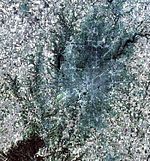
Other municipalities over 20,000 population
(in 2010)Brownsburg • Fishers • Franklin • Greenfield • Greenwood • Lawrence • Noblesville • Plainfield • WestfieldMunicipalities 1,000-20,000 population
(in 2010)Arcadia • Avon • Bargersville • Beech Grove • Brooklyn • Cicero • Clermont • Cloverdale • Cumberland • Danville • Edinburgh • Fairland • Fortville • Greencastle • Lebanon • Martinsville • McCordsville • Mooresville • Morristown • New Palestine • New Whiteland • Pittsboro • Princes Lakes • Shelbyville • Sheridan • Speedway • Southport • St. Paul • Thorntown • Whiteland • ZionsvilleCounties State capitals of the United States AL Montgomery AK Juneau AZ Phoenix AR Little Rock CA Sacramento CO Denver CT Hartford DE Dover FL Tallahassee GA Atlanta HI Honolulu ID Boise IL Springfield IN Indianapolis IA Des Moines KS Topeka KY Frankfort LA Baton Rouge ME Augusta MD Annapolis MA Boston MI Lansing MN Saint Paul MS Jackson MO Jefferson City MT Helena NE Lincoln NV Carson City NH Concord NJ Trenton NM Santa Fe NY Albany NC Raleigh ND Bismarck OH Columbus OK Oklahoma City OR Salem PA Harrisburg RI Providence SC Columbia SD Pierre TN Nashville TX Austin UT Salt Lake City VT Montpelier VA Richmond WA Olympia WV Charleston WI Madison WY Cheyenne DC Washington1
Territories:AS Pago Pago GU Hagåtña MP Saipan PR San Juan VI Charlotte Amalie County seats of Indiana In order by county • Bold indicates county of 100,000+
Decatur • Fort Wayne • Columbus • Fowler • Hartford City • Lebanon • Nashville • Delphi • Logansport • Jeffersonville • Brazil • Frankfort • English • Washington • Lawrenceburg • Greensburg • Auburn • Muncie • Jasper • Goshen • Connersville • New Albany • Covington • Brookville • Rochester • Princeton • Marion • Bloomfield • Noblesville • Greenfield • Corydon • Danville • New Castle • Kokomo • Huntington • Brownstown • Renssalaer • Portland • Madison • Vernon • Franklin • Vincennes • Warsaw • LaGrange • Crown Point • LaPorte • Bedford • Anderson • Indianapolis • Plymouth • Shoals • Peru • Bloomington • Crawfordsville • Martinsville • Kentland • Albion • Rising Sun • Paoli • Spencer • Rockville • Tell City • Petersburg • Valparaiso • Mount Vernon • Winamac • Greencastle • Winchester • Versailles • Rushville • South Bend • Scottsburg • Shelbyville • Rockport • Knox • Angola • Sullivan • Vevay • Lafayette • Tipton • Liberty • Evansville • Newport • Terre Haute • Wabash • Williamsport • Boonville • Salem • Richmond • Bluffton • Monticello • Columbia City50 most populous cities of the United States - Jacksonville
- Indianapolis
- San Francisco
- Austin
- Columbus
- Fort Worth
- Charlotte
- Detroit
- El Paso
- Memphis
(2010 United States Census Bureau)Pan American Games host cities 1951: Buenos Aires • 1955: Mexico City • 1959: Chicago • 1963: São Paulo • 1967: Winnipeg • 1971: Santiago de Cali • 1975: Mexico City • 1979: San Juan • 1983: Caracas • 1987: Indianapolis • 1991: Havana • 1995: Mar del Plata • 1999: Winnipeg • 2003: Santo Domingo • 2007: Rio de Janeiro • 2011: Guadalajara • 2015: Toronto
Municipalities and communities of Marion County, Indiana Cities Beech Grove | Indianapolis (balance) | Lawrence | Southport
Town Townships Included towns
(see Unigov)Clermont | Crows Nest | Cumberland‡ | Homecroft | Meridian Hills | North Crows Nest | Rocky Ripple | Spring Hill | Warren Park | Williams Creek | Wynnedale
Footnotes ‡This populated place also has portions in an adjacent county or counties
 State of IndianaIndianapolis (capital)
State of IndianaIndianapolis (capital)Topics - Index
- Demographics
- Economy
- Geography
- Government
- Governor (List)
- Congressional districts (Delegations)
- History
- Hoosiers
- City Nicknames
- National Historic Landmarks
- Sports
- State parks
- Symbols
- Transportation
- Visitor Attractions
- Index of Indiana-related articles
- Outline
Regions - Central Indiana
- East Central Indiana
- Illinois-Indiana-Kentucky Tri-State Area
- Indiana-Kentucky-Ohio Tri-State Area
- Michiana
- Northern Indiana
- Northwest Indiana
- Southern Indiana
- Southwestern Indiana
- Wabash Valley
Largest cities - Indianapolis
- Fort Wayne
- Evansville
- South Bend
- Hammond
- Bloomington
- Gary
- Carmel
- Lafayette
- Muncie
- Anderson
- Terre Haute
- Elkhart
- Kokomo
- Mishawaka
- Richmond
- Columbus
- Lawrence
- Jeffersonville
- Greenwood
- New Albany
- Portage
- Michigan City
- East Chicago
- Goshen
- Marion
- Valparaiso
- Noblesville
- West Lafayette
- Hobart
- Crown Point
- Franklin
- La Porte
- Seymour
- Logansport
- New Castle
- Connersville
- Vincennes
- Bedford
- Jasper
- Washington
- Princeton
- Westfield
Largest towns Counties - Adams
- Allen
- Bartholomew
- Benton
- Blackford
- Boone
- Brown
- Carroll
- Cass
- Clark
- Clay
- Clinton
- Crawford
- Daviess
- Dearborn
- Decatur
- DeKalb
- Delaware
- Dubois
- Elkhart
- Fayette
- Floyd
- Fountain
- Franklin
- Fulton
- Gibson
- Grant
- Greene
- Hamilton
- Hancock
- Harrison
- Hendricks
- Henry
- Howard
- Huntington
- Jackson
- Jasper
- Jay
- Jefferson
- Jennings
- Johnson
- Knox
- Kosciusko
- LaGrange
- Lake
- LaPorte
- Lawrence
- Madison
- Marion
- Marshall
- Martin
- Miami
- Monroe
- Montgomery
- Morgan
- Newton
- Noble
- Ohio
- Orange
- Owen
- Parke
- Perry
- Pike
- Porter
- Posey
- Pulaski
- Putnam
- Randolph
- Ripley
- Rush
- Saint Joseph
- Scott
- Shelby
- Spencer
- Starke
- Steuben
- Sullivan
- Switzerland
- Tippecanoe
- Tipton
- Union
- Vanderburgh
- Vermillion
- Vigo
- Wabash
- Warren
- Warrick
- Washington
- Wayne
- Wells
- White
- Whitley
Indianapolis Cultural Trail Cultural Districts Public Art Ann Dancing • E Pluribus Unum • Moving Forward • Chatham Passage • Care/Don't Care • Glick Peace Walk • Prairie Modules 1 & 2Categories:- Indianapolis, Indiana
- Indianapolis metropolitan area
- Cities in Indiana
- Consolidated city–counties in the United States
- County seats in Indiana
- Populated places in Marion County, Indiana
- National Road
- Planned cities in the United States
- Populated places established in 1821
Wikimedia Foundation. 2010.


